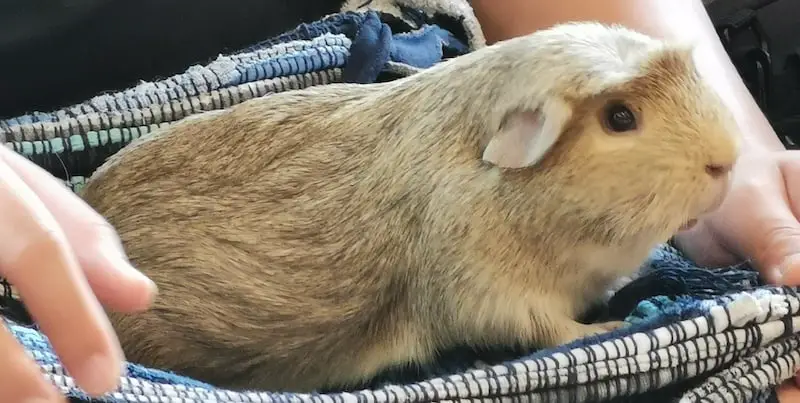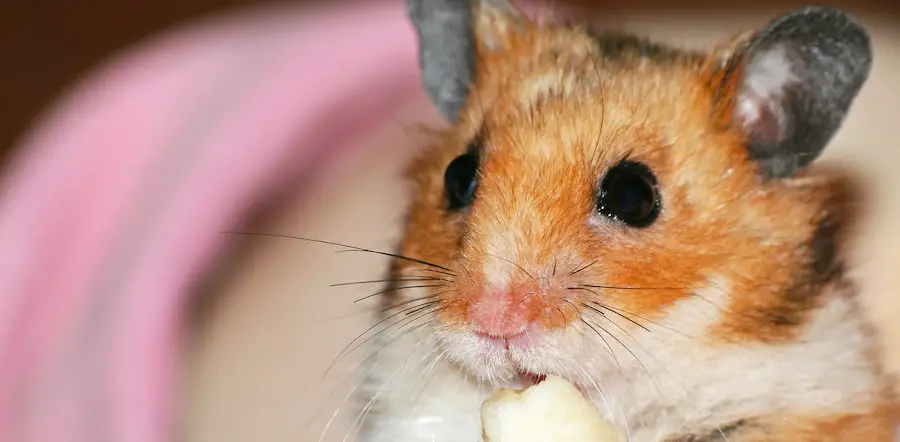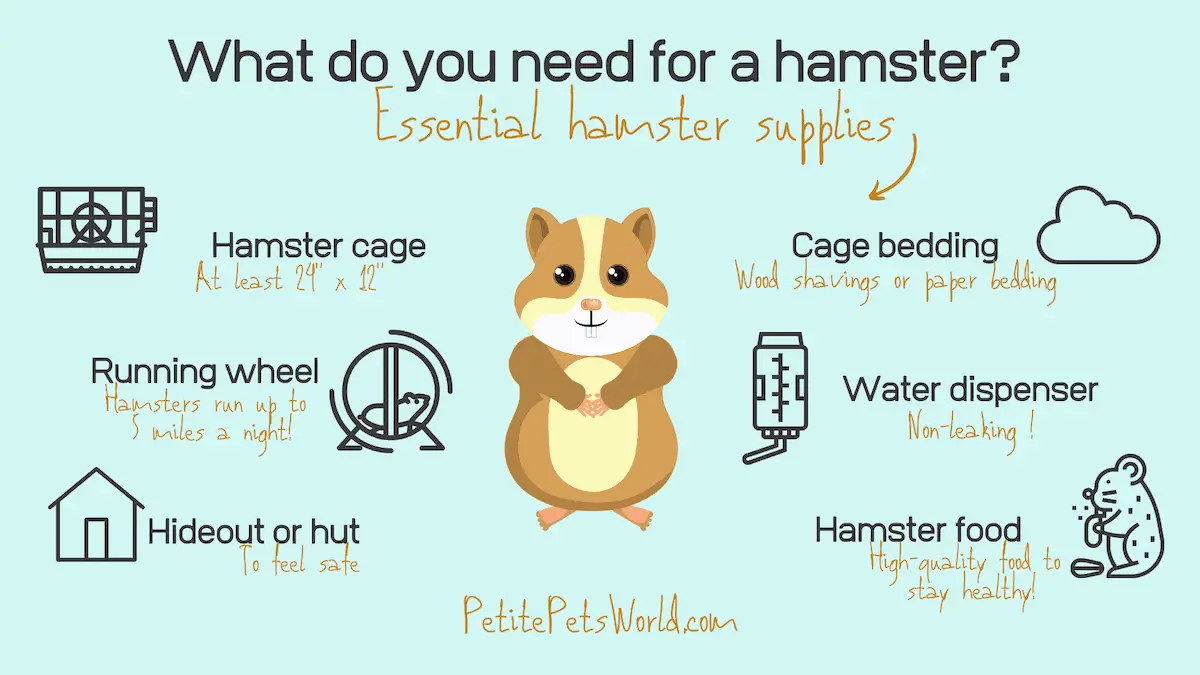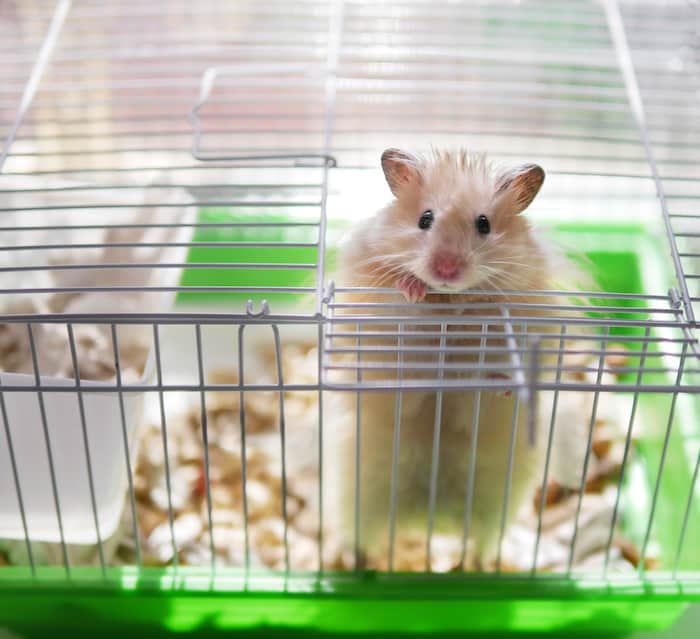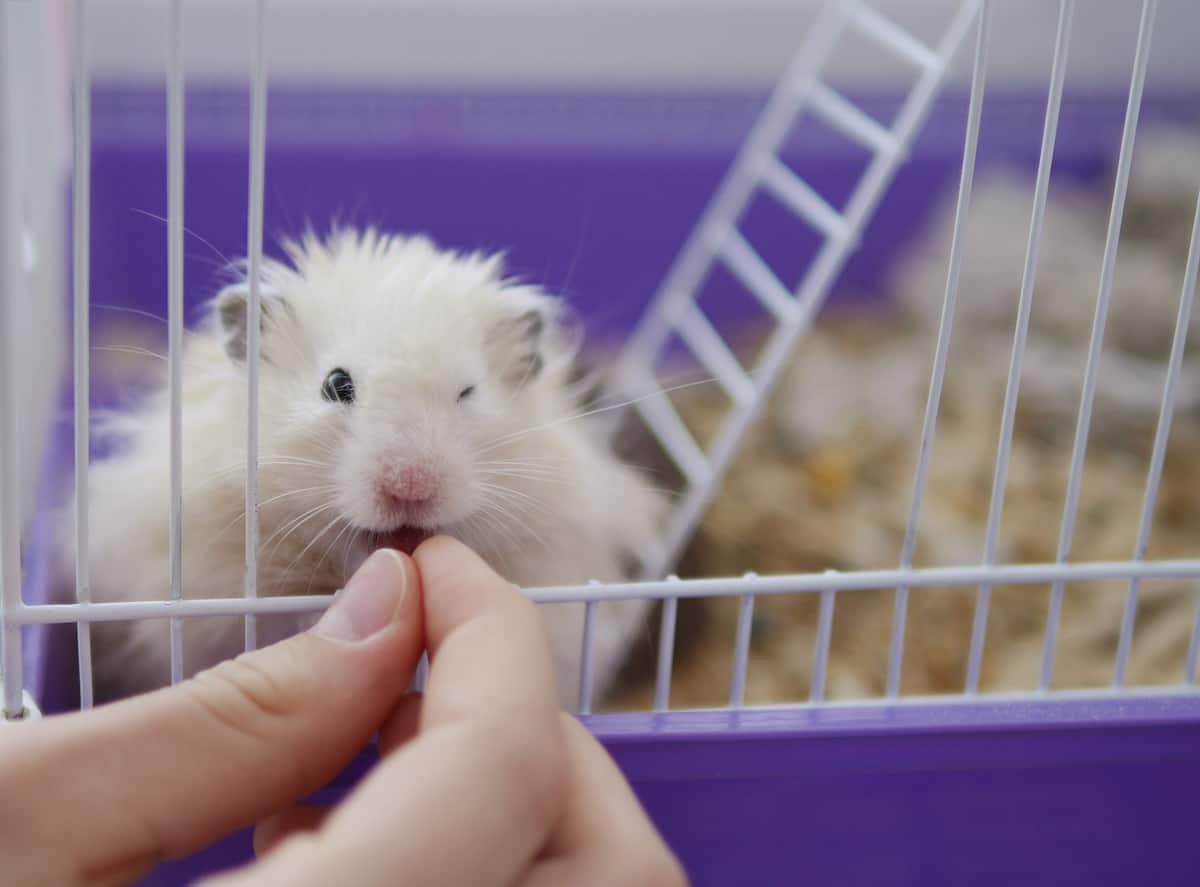Last Updated on
Dwarf hamsters are pocket pets really small in size. An adult dwarf hamster can weigh up to 2 ounces and grow up to 5 centimeters long.
However, despite their tiny nature, they're very energetic and thrive off of moving a lot and require more space than you may think.
If you're an owner of these tiny powerhouses, finding the perfect cage for them should be your priority to keep them healthy and happy.
This buying guide will give you the information that you need to purchase the best cage for your dwarf hamster.
Here's what's coming up:
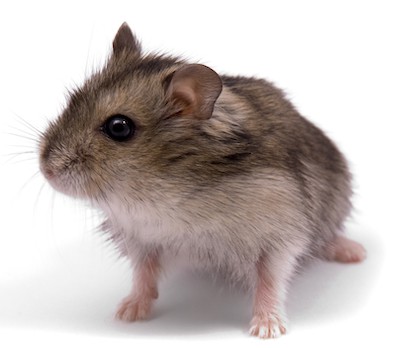
*PetitePetsWorld strives to be a valuable resource for pet owners. We select and review all products independently; however, we may earn affiliate commissions when you buy through links on our site.
Best Cages for Dwarf Hamsters
TOP 3 in 2021
Ferplast Favola Hamster Cage
Key Featutes
- Two-story structure creating ample space
- Ideal bar spacing for dwarf hamsters
- Safe, sturdy and secure
- A deep transparent base for burrowing
- All accessories are included
- Hamster friendly plastic ramp provides access to the upper level
- The top level houses the food dish, water, and hideaway
- Equipped with a large 5.5-inch exercise wheel
- Designed with a connecting port for add-ons
- Access door fitted on the top panel
- Cage measures 23.6 x 14.4 x 11.8 inches
- Wire top with ¼-inch bar spacing
Summary:
The Ferplast Favola Hamster Cage has been designed with a considerably sized see-through plastic base and wire-mesh top. This savvy dwarf hamster home provides a structure which comprises two levels and connects with a plastic ladder. The design will keep your hamster active by offering them ample space for digging, exercise, and staying active.
The plastic ladder is pinch-free and will not harm your furry, little friend. The bottom floor, which can hold a good amount of hamster bedding, can be reserved for burrowing, exercise, and playing. At the same time, food, water, and treats can be kept clean by placing them on the upper level.
There is a secure door on the top for feeding your hamster, and the bar spacing is ideal for keeping your dwarf hamster safe. The top and bottom are easily separated for cleaning by pulling the latches on each side. With this practical cage, cleaning and maintenance are fuss-free.
Accessories that are included with the Favola Hamster Cage include a hamster hideaway, a food dish, a drinking bottle, and a wheel, which allows for great physical stimulation. Another great thing about this cage is that you can easily expand it by adding tunnels and other accessories!
Pros
+ Ideal bar spacing for dwarf hamsters
+ Secure and safe
+ Spacious to keep your hamster active and happy
+ Everything you need is included
+ A wide, deep base can be filled with bedding to meet your hamster's natural burrowing needs
+ Quick clean-ups and food refills are made simple with the small door at the top of the cage
+ Cleaning the cage or changing the litter is made easy with side clips to separate the top and the bottom
+ You can expand the cage with tunnels and other accessories
Cons
- Lack of side door
Prevue Pet Products Universal Cage
Key Featutes
- Good-sized cage for dwarf hamsters
- Sturdy yet lightweight
- Rounded corners and no pinch points
- Deep bottom section for digging and burrowing
- Two levels for a more stimulating environment
- Two large entry doors on the top and the side
- Secured with six firm latches
- Cage measurements 32.5 x 19 x 17.5 inches
Summary:
This Prevue Pet Universal Small Animal Cage has a deep 6.5-inch bottom section you can fill with bedding and toys for your hamster to play with. Dwarf hamsters often enjoy burrowing and digging, and this cage is an excellent choice for that. This home will offer your hammy a great space to play and help them stay active and healthy.
The cage also has a platform with room to keep your hamster's food and other snacks separate from the play area and clean. The platform also makes the environment more interesting for your pet and offers them even more room.
Access to the cage is easy with two large entry points placed at the top and front, making quick clean-ups and feeding an easy task! A latch locking mechanism is used at each door to keep your pet safely secured and away from potential hazards around the home.
The lightweight design of the cage allows you to easily move your hamster's home from one room to the next without any unnecessary fuss. This pet cage makes for a great purchase, giving you peace of mind and your hamster a safe and cozy home.
Pros
+ Abundant space for your dwarf hamster
+ Sturdy and secure with six latches
+ Deep bottom tray for mess-free burrowing
+ Assembling the cage is an easy task
+ Two doors make clean-ups and feeding times fuss-free
+ Rounded corners with no pinch-points
+ Lightweight structure and handles for portability
Cons
- Ramp and platform may wear out, but replacements are available
- Not quite as sturdy as pricier cages
You & Me Small Animal High Rise Tank Topper
Key Featutes
- Tank topper for 10-gallon tanks
- Fully assembled for convenience
- Tight bar spacing for dwarf hamsters
- Comes with a platform
- A door on the top for feeding and cleanups
- Includes two hooks for attaching the topper to the tank
- The tank topper measures at 19.25 x 9.75 x 11.5 inches
Summary:
Your 10-gallon tank can provide room for sufficient hamster bedding to promote burrowing and provide your pet with the stimulation it requires. However, your dwarf hamster will need more space, and this tank topper is a great way to add more room to your hamster's home.
Any hamster would love the extra space the tank topper offers – add in a ramp and fun accessories and watch your hamster explore even more!
The You & Me Small Animal High Rise Tank Topper conveniently fits onto a 10-gallon tank to create more space for your dwarf hamster. The tank topper is designed with a door at the top to make the living space easily accessible and allowing quick cleaning and easy feeding times.
The topper also includes a platform encouraging curiosity and a great viewing point for your pet to observe their surroundings.
Pros
+ Adds more space to a 10-gallon tank
+ Tight bar spacing for dwarf hamsters
+ Secure and safe
+ Offers a clean area for feeding and other activities than burrowing
+ Allows kids to observe burrowing while keeping the pet safe
+ The ramp allows hamsters to run between the different levels
+ Decently priced addition to your 10-gallon tanks
Cons
- Covering the ramp with felt may make it more comfortable for sensitive hamsters
Types of Cages for Dwarf Hamsters
There are different types of cages for dwarf hamsters available in the market.
Some pet owners prefer to keep their dwarf hamsters in metal bars while others prefer an aquarium-like tank. You need to choose a cage that fits your needs and helps keep your hamster safe at the same time.
Below are the different cage options to choose from:
Wire-Top Dwarf Hamster Cages

These are the classic cages for dwarf hamsters that have been used by pet owners for a long time. This is because they are:
- durable,
- cheap, and
- easy to clean.
They provide enough space for your hamster to move and can have more levels in them for more than one hamster.
The main setback for these wire cages is that they allow dwarf hamsters to escape—especially since they can be the best escape artists. To avoid this from happening, make sure that the bar spacing is narrow, and there are no gaps and holes that can easily allow your pet to escape.
Another setback of the metal cage is that it can produce a lot of noise—especially if your dwarf hamster decides to climb up the cages or likes gnawing at the bars. It will be better to put the cage away from your bedroom to avoid disruptive noise while you're sleeping.
This cage is perfect for housing more than one dwarf hamster depending on its size, and you can add accessories such as wheels to keep the hamster(s) entertained.
Hamster Glass Aquariums/Fish Tanks
An aquarium is beneficial in that there is less chance for your dwarf to escape because there are no metal bars or gaps for them to try and squeeze in between.
Another benefit of keeping your dwarf hamster in an aquarium is that it allows you to watch your pet without any metal bar intrusion. These cages are also quieter, and your hamster may not be able to climb up, making it ideal for keeping it near you when you are sleeping.
The main setback for this type of cage is the price—since a new aquarium can be expensive. You can find a cheap second-hand aquarium online, but the big tanks will not be cheap. It's also not so easy to clean an aquarium since they are pretty heavy to maneuver and that might be a bit of a hassle since it's ideal to clean it out every week.
The traditional aquarium comes with no tank topper to allow for maximum ventilation and prevent the build-up of ammonia, which can help keep your dwarf hamster healthy.
Small Animal Habitats
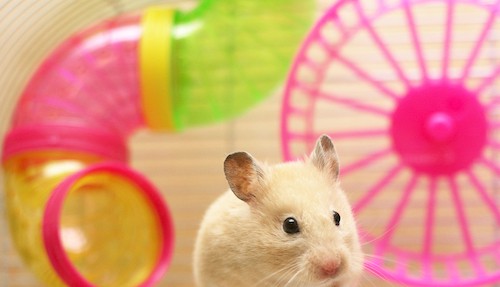
Some owners argue that they are too small, while others prefer the simulation that they provide.
Although these cages don't have a huge amount of space, they provide plenty of activity. They are the most varied habitat for your pet and give an interesting environment that can be a great killer for boredom.
The best way to use this habitat for your dwarf hamster is to buy a few of them separately and link them up using tubes and tunnels. This way, you can create a hamster mansion that will provide enough space for your pet to exercise and explore.
This type of cage may also be expensive because of the hamster toys and other parts that have been incorporated.
11 Features to Consider
When Buying a Cage for a Dwarf Hamster
The following features will help you in deciding the best cage for your dwarf hamster:
[1.] Size
Dwarf hamsters can be tiny creatures—but they are full of energy.
They explore, move a lot, and run wild. A small cage can cause boredom for them. It can also affect the temperature of your dwarf hamster and its ability to respond to illnesses or infections.
Wild hamsters are known to travel up to 5 miles in one night; therefore, it is better to buy a bigger cage if you can. You can expand your hamster's cage by connecting it to other cages.
According to regulations, the minimum size should be 24 x 12 inches, and the height of the cage should be a minimum of 12 inches tall.
[2.] Material
Apart from providing good ventilation, wire cages are safer for your dwarf hamster because they cannot chew through the wire and escape.
This, of course, only applies if the bar spacing is suitable for a small pet.
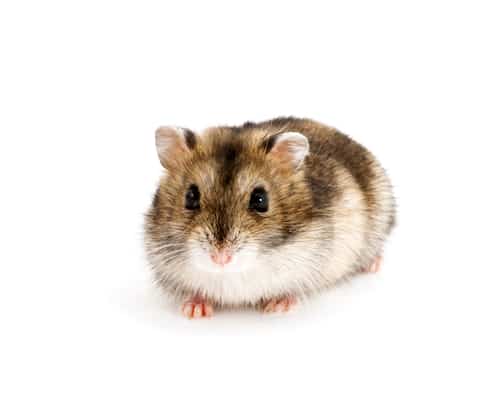
On the other hand, cages made of plastic are vulnerable to chewing by your hamster and may not give enough ventilation if not designed properly. However, plastic is durable and easy to clean.
You can also choose to buy a tank—which is more durable and will be less of a problem when it comes to escaping.
[3.] Ventilation
Fresh air is necessary for the good health of your dwarf hamster.
Generally, wire cages provide the best ventilation. However, some aquariums and modular cages, although they have various compartments, don't provide enough ventilation for your pet unless you leave the top of the aquarium open.
When buying these types of cages, make sure to pick one that has a proper design to ensure fresh air for your pet.
[4.] Ease of Cleaning
Since you'll be cleaning around once a week, good cages should be designed to make the cleaning process easier. They can have bases that are detachable for easy cleaning.
The easiest type of cage to clean is the wire cage with a plastic tray.

All you need to do when cleaning this cage is to lift the wire off the bottom, clean the bedding and wipe the base and the wire.
Elaborate cages that have a lot of compartments with tubes and other accessories are more difficult to clean, but if they can be rinsed with water, cleaning should not be a problem.
[5.] Bar Spacing
Since dwarf hamsters are tiny creatures, they can easily squeeze through the bar spacings and escape.
This can be dangerous since they can be easily injured while outside their cage. The ideal bar spacing for your dwarf hamster is a quarter-inch.
[6.] Accessibility
The cage you purchase for your dwarf hamster should be easily accessible for cleaning and replacing their food and water.
The cage should have a lid with a decent size that you can put your hand in when cleaning or removing things from the cage. You shouldn't have to remove a whole part of the cage or take it completely apart.
[7.] Hiding Spaces

Dwarf hamsters like to hide because it is their normal burrowing behavior—especially as wild prey.
They love to explore and create hideaways mostly beneath their bedding for playing and sleeping. They also like hiding spaces for their food.
Having a cage with tunnels, structures, and hideaways for your dwarf hamster will allow them to feel at home.
[9.] Toys
Dwarf hamsters need different types of toys to allow them to play, explore, and exercise. Having toys inside the cage is important for exercise purposes.
You can get them:
- Hamster wheels with a proper size and solid surface to prevent injury.
- Plastic balls can also keep your pet running around and is a great way for them to exercise.
- Chew toys are necessary to keep their constantly growing teeth in good condition.
[10.] Portability
You should be able to move your dwarf hamster's cage from one part of your house to another without much difficulty.
There are portable cages for dwarf hamsters available on the market, and you can find one that suits your needs and that of your pet. The cage should not be heavy to carry around or move it when you want—or need—to clean.
[11.] Levels
Some cages have just one level, while others have multiple levels.
Cages with multiple levels can be dangerous because your hamster can easily fall, but they can provide a more intriguing environment—especially if you own more than one hamster.
Accessories – What do Dwarf Hamsters Need in their cage?
Similar other species of hamsters, the dwarf hamster cage requires some basic essential supplies, these include:
Aspen is widely regarded and has the safest bedding material for dwarf hamsters. Other woods like cedar and pine can be quite dangerous.
For the nest, cotton materials are most suitable.
Your dwarf hamster needs access to food inside the cage.
Find a small food container that can easily hold food pellets. Another essential is water access—a small hanging water bottle that has a spout for the hamster to drink from is a necessary accessory. Most cages will actually include a water bottle.
Like humans, dwarf hamsters require physical exercise to maintain a healthy, balanced life. Since they live most of their life inside, they need access to exercise equipment inside the cage.
The most common exercise piece is the wheel, but you can also purchase small climbing frames to keep your dwarf hamster physically stimulated.
Everyone deserves the right to privacy, even your dwarf hamster!
Build them small sleeping quarters inside the cage so they can peacefully shut off from the world and relax in their own space.
How to Clean a Dwarf Hamster Cage
One of the best advantages of having a dwarf hamster is that they like to de-compartmentalize their living quarters and will keep their sleeping, playing, and toilet facilities very separate.
That being said, there are some important tips you should follow to help clean and maintain your hamsters to ensure they have a maximum lifespan.
Daily Spot Clean: Every day, you should wipe down its potty and remove any soiled bedding to prevent the spread of any disease.
Weekly Full Clean: The entire cage should be cleaned every week. This should be done on the same day every week to ensure your furry friend knows the routine.
Place the hamster in a safe place while cleaning: It goes without saying, but do make sure you keep the hamster in a secure location while you have removed it to clean the cage.
Cleaning Everything: At least once a week, wipe down all the surfaces and wire bars with hot water and antibacterial soap to ensure the cage is free from any harmful bacteria.
White vinegar for odors: If the cage is a bit smelly, use white vinegar to wipe down the surface since this is an effective, natural way to remove odor.
*Disclaimer: As an Amazon Associate we earn from qualifying purchases. That means we receive a small commission from Amazon if you should decide to purchase a product through our link - but don’t worry, you won’t be charged any extra for it.
We only recommend products we truly believe are of value to you, and we believe in ourselves. Our goal is to make this site a truly valuable resource for all pet owners.



